The American Trends Panel survey methodology
Overview
Data in this report comes from Wave 168 of the American Trends Panel (ATP), Pew Research Center’s nationally representative panel of randomly selected U.S. adults. The survey was conducted from April 14 to April 20, 2025. A total of 9,397 panelists responded out of 10,559 who were sampled, for a survey-level response rate of 89%.
The cumulative response rate accounting for nonresponse to the recruitment surveys and attrition is 3%. The break-off rate among panelists who logged on to the survey and completed at least one item is 1%. The margin of sampling error for the full sample of 9,397 respondents is plus or minus 1.3 percentage points.
SSRS conducted the survey for Pew Research Center via online (n=9,136) and live telephone (n=261) interviewing. Interviews were conducted in both English and Spanish.
To learn more about the ATP, read “About the American Trends Panel.”
Panel recruitment
Since 2018, the ATP has used address-based sampling (ABS) for recruitment. A study cover letter and a pre-incentive are mailed to a stratified, random sample of households selected from the U.S. Postal Service’s Computerized Delivery Sequence File. This Postal Service file has been estimated to cover 90% to 98% of the population. Within each sampled household, the adult with the next birthday is selected to participate. Other details of the ABS recruitment protocol have changed over time but are available upon request. Prior to 2018, the ATP was recruited using landline and cellphone random-digit-dial surveys administered in English and Spanish.
A national sample of U.S. adults has been recruited to the ATP approximately once per year since 2014. In some years, the recruitment has included additional efforts (known as an “oversample”) to improve the accuracy of data for underrepresented groups. For example, Hispanic adults, Black adults and Asian adults were oversampled in 2019, 2022 and 2023, respectively.
Sample design
The overall target population for this survey was noninstitutionalized persons ages 18 and older living in the United States. All active panel members were invited to participate in this wave.
Questionnaire development and testing
The questionnaire was developed by Pew Research Center in consultation with SSRS. The web program used for online respondents was rigorously tested on both PC and mobile devices by the SSRS project team and Pew Research Center researchers. The SSRS project team also populated test data that was analyzed in SPSS to ensure the logic and randomizations were working as intended before launching the survey.
Incentives
All respondents were offered a post-paid incentive for their participation. Respondents could choose to receive the post-paid incentive in the form of a check or gift code to Amazon.com, Target.com or Walmart.com. Incentive amounts ranged from $5 to $20 depending on whether the respondent belongs to a part of the population that is harder or easier to reach. Differential incentive amounts were designed to increase panel survey participation among groups that traditionally have low survey response propensities.
Data collection protocol
The data collection field period for this survey was April 14 to April 20, 2025. Surveys were conducted via self-administered web survey or by live telephone interviewing.
For panelists who take surveys online: Postcard notifications were mailed to a subset on April 14. Survey invitations were sent out in two separate launches: soft launch and full launch. Sixty panelists were included in the soft launch, which began with an initial invitation sent on April 14. All remaining English- and Spanish-speaking sampled online panelists were included in the full launch and were sent an invitation on April 15.
Panelists participating online were sent an email invitation and up to two email reminders if they did not respond to the survey. ATP panelists who consented to SMS messages were sent an SMS invitation with a link to the survey and up to two SMS reminders.
For panelists who take surveys over the phone with a live interviewer: Prenotification postcards were mailed on April 11. Soft launch took place on April 14 and involved dialing until a total of eight interviews had been completed. All remaining English- and Spanish-speaking sampled phone panelists’ numbers were dialed throughout the remaining field period. Panelists who take surveys via phone can receive up to six calls from trained SSRS interviewers.
Data quality checks
To ensure high-quality data, Center researchers performed data quality checks to identify any respondents showing patterns of satisficing. This includes checking for whether respondents left questions blank at very high rates or always selected the first or last answer presented. As a result of this checking, two ATP respondents were removed from the survey dataset prior to weighting and analysis.
Weighting
The ATP data is weighted in a process that accounts for multiple stages of sampling and nonresponse that occur at different points in the panel survey process. First, each panelist begins with a base weight that reflects their probability of recruitment into the panel. These weights are then calibrated to align with the population benchmarks in the accompanying table to correct for nonresponse to recruitment surveys and panel attrition. If only a subsample of panelists was invited to participate in the wave, this weight is adjusted to account for any differential probabilities of selection.
Among the panelists who completed the survey, this weight is then calibrated again to align with the population benchmarks identified in the accompanying table and trimmed at the 1st and 99th percentiles to reduce the loss in precision stemming from variance in the weights. Sampling errors and tests of statistical significance take into account the effect of weighting.
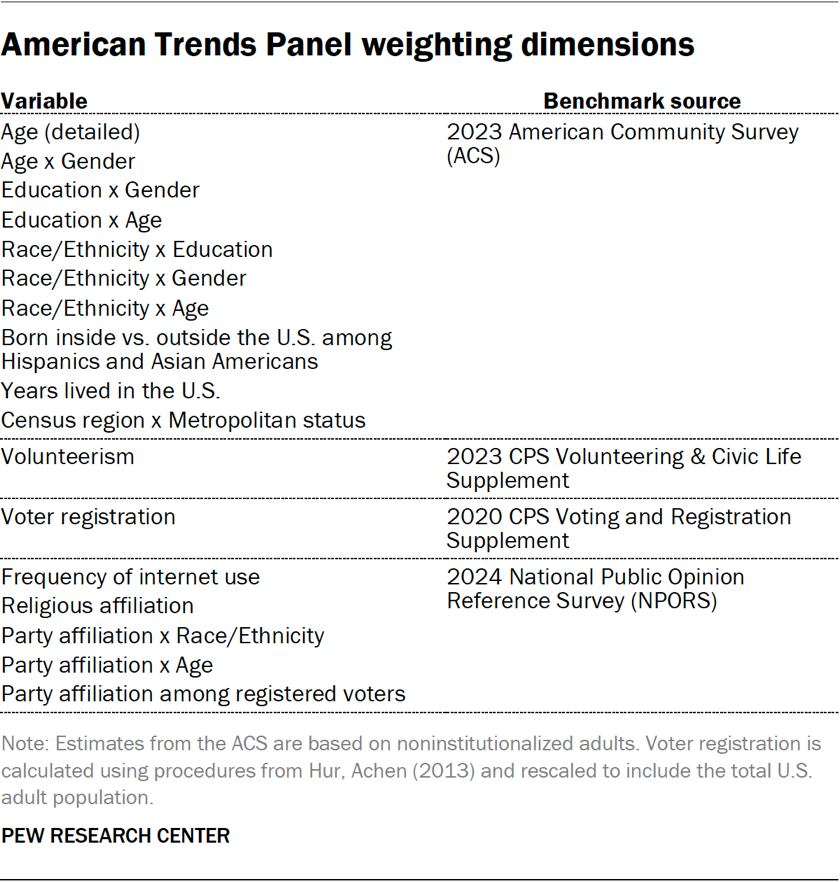
The following table shows the unweighted sample sizes and the error attributable to sampling that would be expected at the 95% level of confidence for different groups in the survey.
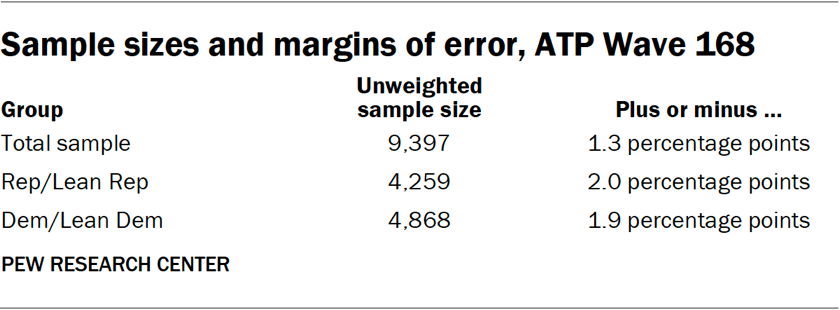
Sample sizes and sampling errors for other subgroups are available upon request. In addition to sampling error, one should bear in mind that question wording and practical difficulties in conducting surveys can introduce error or bias into the findings of opinion polls.
Dispositions and response rates
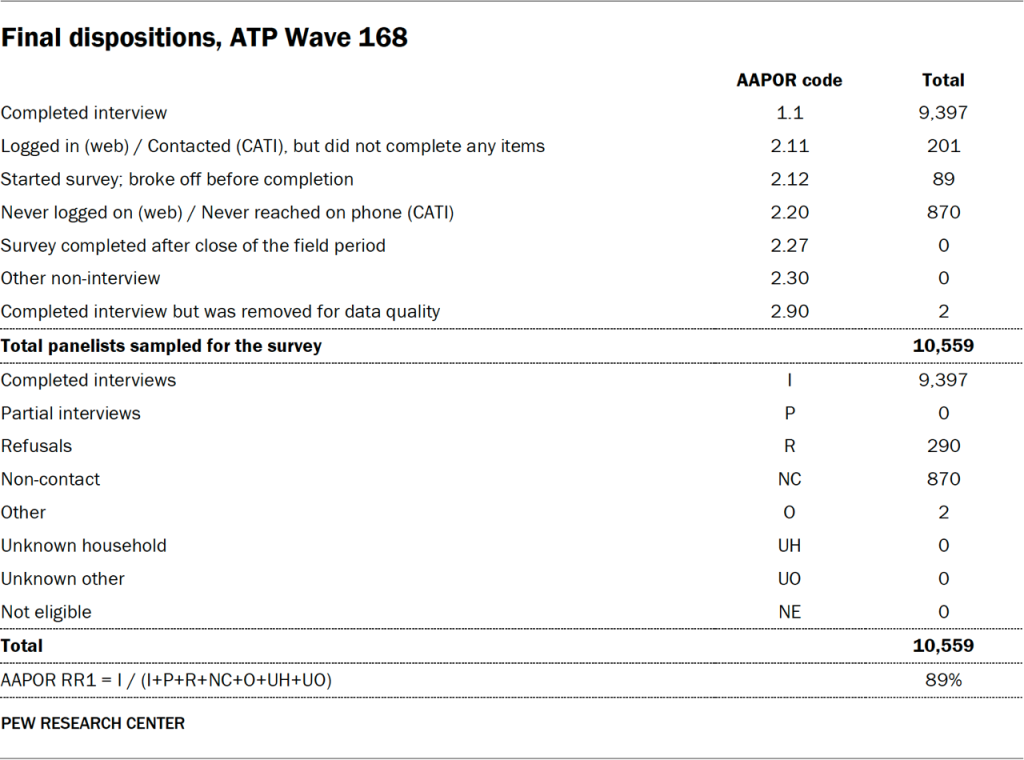
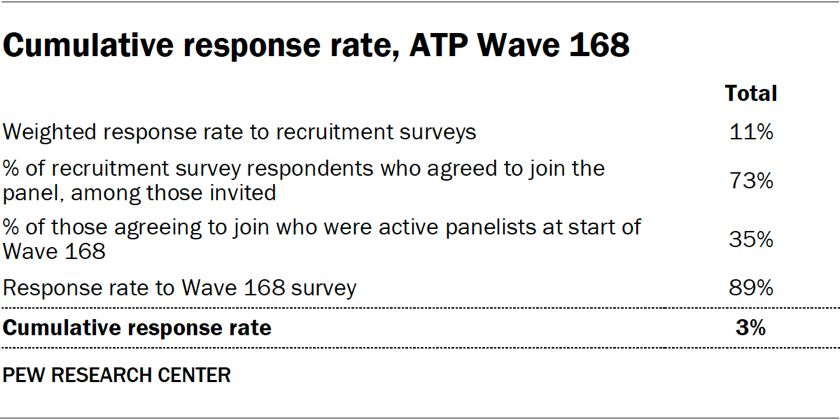
How family income tiers are calculated
Family income data reported in this study is adjusted for household size and cost-of-living differences by geography. Panelists then are assigned to income tiers that are based on the median adjusted family income of all American Trends Panel members. The process uses the following steps:
- First, panelists are assigned to the midpoint of the income range they selected in a family income question that was measured on either the most recent annual profile survey or, for newly recruited panelists, their recruitment survey. This provides an approximate income value that can be used in calculations for the adjustment.
- Next, these income values are adjusted for the cost of living in the geographic area where the panelist lives. This is calculated using price indexes published by the U.S. Bureau of Economic Analysis. These indexes, known as Regional Price Parities (RPP), compare the prices of goods and services across all U.S. metropolitan statistical areas as well as non-metro areas with the national average prices for the same goods and services. The most recent available data at the time of the annual profile survey is from 2022. Those who fall outside of metropolitan statistical areas are assigned the overall RPP for their state’s non-metropolitan area.
- Family incomes are further adjusted for the number of people in a household using the methodology from Pew Research Center’s previous work on the American middle class. This is done because a four-person household with an income of say, $50,000, faces a tighter budget constraint than a two-person household with the same income.
- Panelists are then assigned an income tier. “Middle-income” adults are in families with adjusted family incomes that are between two-thirds and double the median adjusted family income for the full ATP at the time of the most recent annual profile survey. The median adjusted family income for the panel is roughly $74,100. Using this median income, the middle-income range is about $49,400 to $148,200. Lower-income families have adjusted incomes less than $49,400 and upper-income families have adjusted incomes greater than $148,200 (all figures expressed in 2023 dollars and scaled to a household size of three). If a panelist did not provide their income and/or their household size, they are assigned “no answer” in the income tier variable.
Two examples of how a given area’s cost-of-living adjustment was calculated are as follows: the Pine Bluff metropolitan area in Arkansas is a relatively inexpensive area, with a price level that is 19.1% less than the national average. The San Francisco-Oakland-Berkeley metropolitan area in California is one of the most expensive areas, with a price level that is 17.9% higher than the national average. Income in the sample is adjusted to make up for this difference. As a result, a family with an income of $40,400 in the Pine Bluff area is as well off financially as a family of the same size with an income of $58,900 in San Francisco.
Focus groups
Pew Research Center worked with PSB Insights to conduct nine 90-minute online focus groups with a total of 45 U.S. adults from June 10 to 18, 2025. These discussions are not nationally representative, and the results are not framed in quantitative terms. This report includes findings and quotes from the first half of these focus groups to help illustrate and add nuance to the survey findings. Quotes were lightly edited for spelling, punctuation and clarity.
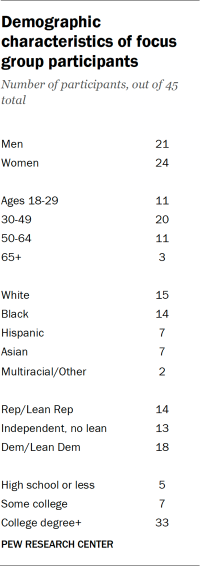
Recruitment
PSB Insights recruited participants using quotas for gender, age, party affiliation, education, race and ethnicity, self-reported news engagement level and primary medium of news consumption. All participants had to be 18 years of age or older (19 or older if living in Alabama or Nebraska and 21 or older if living in Mississippi), live in the U.S., and have access to a computer or mobile device with high-speed internet access and a working webcam.
Lastly, eligible participants had to be willing and able to contribute to the research, complete an online pre-session activity, attend the focus group on the set date and time, and sign an informed consent form before they could participate. This included agreement that all responses could be used in research reports, though participants’ names and identifying information would remain private and not be used in any reports.
For each focus group, seven participants were recruited and five were ultimately selected to participate. The research team overrecruited participants to account for “no-shows,” as well as participants who may experience other issues preventing participation. Each participant was offered a $225 incentive.
The first six focus groups were segmented by political affiliation (Republicans, Democrats and independents) and primary news source (traditional vs. nontraditional) to ensure that multiple perspectives on news were gathered. Traditional news sources included television, radio, print publications, and news websites or apps noted as a participant’s primary source of news. Nontraditional sources included social media, search engines, podcasts, online forums and email newsletters noted as a participant’s primary source of news.
Additional focus groups were conducted with Americans under the age of 30, those ages 50 and older, and those with low self-reported news engagement.
Online pre-session activity
Before each focus group, participants completed a pre-session activity including both written and video response questions. This assisted the research team in guiding the discussion within the groups. Additionally, it primed the participants on the general topic of the discussion prior to the start of the focus groups.
Discussion
The Pew Research Center and PSB Insights research teams developed the discussion guide through an iterative process. Minor edits were made to the discussion guide after the first focus group, including cutting some questions and tweaking the language of others to dig deeper into our key areas of interest.
After the moderator established ground rules and participants introduced themselves, each focus group discussed two sets of topics included in analyses for this report:
- What is a journalist? This section examined perceptions of journalists and alternative news sources like podcasters and influencers, focusing on qualities and expectations. It explored views on original reporting, authenticity, opinions in news, and how people assess the credibility and transparency of news providers.
- The role of journalists: This section explored the role of journalists in society, including their responsibilities, public trust and the impact of newer sources like influencers and podcasters on those perceptions. It examined views on advocacy, neutrality and the importance of watchdog journalism in accountability, as well as where journalists succeed or fall short in these roles.
Analysis
All human-generated transcripts were analyzed and coded by the Pew Research Center research team in ATLAS.ti, a qualitative data analysis and research software program.
Two members of the research team compiled analytical memos while observing each focus group, noting similarities and differences across participants and connecting individual experiences and perspectives to broader themes. Two coders also individually analyzed each focus group transcript in ATLAS.ti, using a codebook generated and revised both deductively (before analysis, based on the survey findings) and inductively (during analysis, based on participants’ responses). Once coding was complete, the research team compiled findings and key quotes.
Together, these exercises allowed us to identify key patterns across the data and then use ATLAS.ti to organize and classify all relevant quotes, as well as to match those quotes to the demographic characteristics of those who said them. We took care to ensure that multiple research team members observed and analyzed the focus groups and that the viewpoints expressed in this report accurately captured the range of opinions and experiences of our participants.
Reporting
This report includes select quotations of responses from participants. Quoted matter was lightly edited by Pew Research Center staff for spelling, punctuation and clarity prior to publication.
Great Job Jcoleman & the Team @ Pew Research Center Source link for sharing this story.





